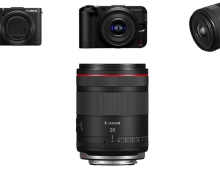
Canon Joins Sony, Nikon in the Mirrorless Digital Camera Battle
Canon is entering the full-frame mirrorless camera market, joining Sony and Nikon in a new battleground for professional-grade camera equipment.
The company will begin selling in late October the EOS R for 237,500 yen ($2,130), a price tag targeted at professionals and enthusiasts. It aims to move 20,000 units a month.
Sony took the lead in the market with devices equipped with sensors that are better at grabbing more light, making it easier for photographers to shoot crisper images of fast-moving objects.
Removing the mirror system in the EOS R reduces the distance between the lens and the image sensor. The tighter design will boost stability, help eliminate blur, and opens possibilities for new lens designs, executives said. Older Canon lenses will still be supported through mount adapters.
The EOS R features a 30.3 effective Megapixel CMOS sensor and a DIGIC 8 processor. It uses RF-mount lenses - four of which will be available at launch - with support for both EF and EF-S lenses via one of three optional adapters, which it says add capability to existing lenses. Dual Pixel AF is onboard, with a whopping 5,655 selectable points with 88% vertical and 100% horizontal coverage, plus the ability to focus down to -6EV.

The camera has a native ISO range of 100-40,000 that expands to 50-102,400. The EOS R supports both Canon's 14-bit CRW Raw format as well as the relatively new C-Raw, which offers much smaller file sizes. The fastest shutter speed available is 1/8000 sec, with an X-sync speed of 1/200 sec.
In terms of design, the EOS R is an SLR-style camera with a weather-sealed magnesium alloy body. It offers an electronic viewfinder with a resolution of 3.69 million dots, a magnification of 0.76x and a 23mm eyepoint. Its fully articulating 3.2" LCD is touch-enabled and has 2.1 million dots. A customizable touchpad to the right of the viewfinder allows for quickly changing ISO, white balance, movie shooting and more. The EOS R offers just one memory card slot, which supports UHS-II media. The camera has HDMI, USB-C, wired remote, headphone and microphone sockets. Wi-Fi and Bluetooth are built-in.
The camera can shoot continuously at 8 fps in AF-S and 5 fps in AF-C 'shooting speed priority' mode. If you want to use 'tracking priority' mode in AF-C the frame rate drops to just 3 fps. The buffer is able to save 47 Raw, 78 C-Raw or 100 JPEGs when shooting at full speed with a UHS-II card. It uses the familiar LP-E6N battery pack which allows for 370 shots per charge using the LCD (per CIPA standard) or 350 with the EVF. The optional BG-E22 grip fills the battery slot but has room for two batteries.
The camera retains separate exposure and button customization settings for video. However, it maxes out at 4K/30p and features the same 1.7x crop that essentially reduces the camera down to sub APS-C quality and still appears to exhibit significant rolling shutter.
Photographers can choose between ALL-I and IPB compression, with top bit rates of 420Mbps and 120Mbps, respectively. Dropping down to Full HD allows for 60 fps recording at 180 Mbps using ALL-I compression. You can output 10-bit 4:2:2 video over HDMI or record internally at 8-bit 4:2:0. Canon Log is supported right out the box at 8-bit 4:2:2 over HDMI or 4:2:0 internally.
The camera can also record 120p footage at 1280 x 720 at a 160Mbps bit rate. Recording time limits are 7.5 minutes for 120 fps shooting and just under 30 minutes for everything else.
The EOS R will be available in October for $2299 body only or $3399 with the 24-105mm F4L lens.
Canon and Nikon have dominated the pro market for decades, first with film and then with digital single-lens reflex (DSLR) cameras. However, devices without the mirror-and-prism system offer significant benefits. Thanks to advanced image sensors, sophisticated software and a simpler design, mirrorless systems can capture light faster while staying in focus, making it easier to capture clearer images of rapidly moving objects.
While mirrorless cameras have been around for more than a decade, Sony was first to embed them with the larger full-frame image sensors - the chips that convert light particles into digital bits - putting them on par with DSLRs in terms of picture quality.





















